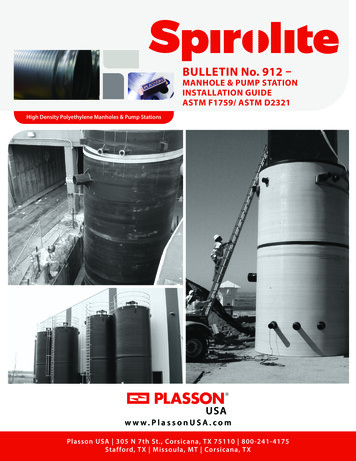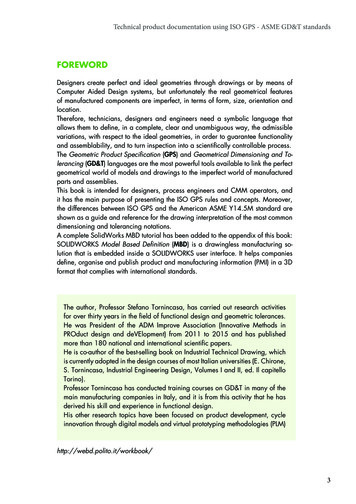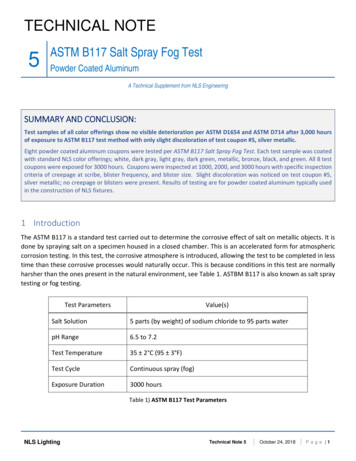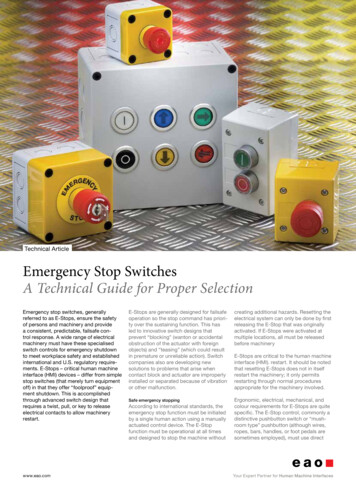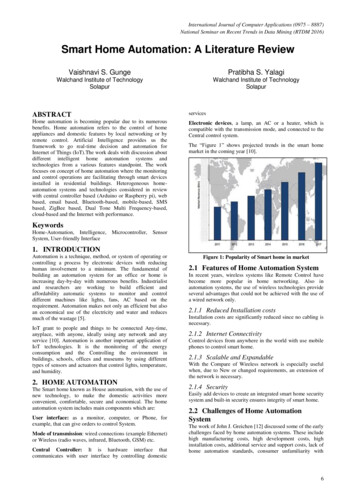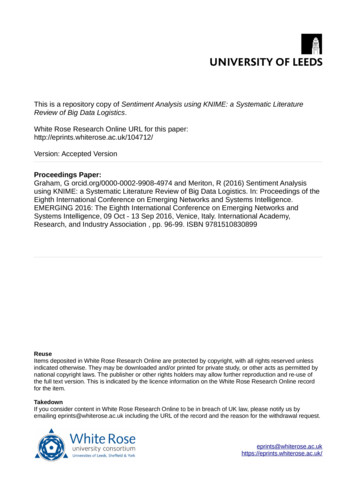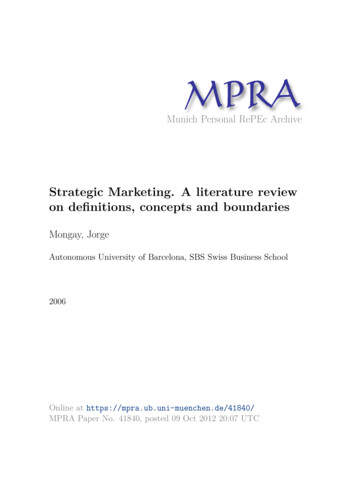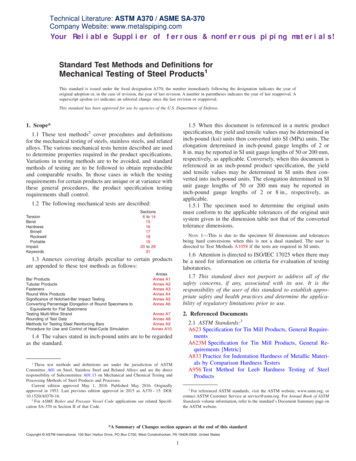
Transcription
Technical Literature: ASTM A370 / ASME SA-370Company Website: www.metalspiping.comYour Reliable Supplier of ferrous & nonferrous piping materials!Standard Test Methods and Definitions forMechanical Testing of Steel Products1This standard is issued under the fixed designation A370; the number immediately following the designation indicates the year oforiginal adoption or, in the case of revision, the year of last revision. A number in parentheses indicates the year of last reapproval. Asuperscript epsilon ( ) indicates an editorial change since the last revision or reapproval.This standard has been approved for use by agencies of the U.S. Department of Defense.1. Scope*1.5 When this document is referenced in a metric productspecification, the yield and tensile values may be determined ininch-pound (ksi) units then converted into SI (MPa) units. Theelongation determined in inch-pound gauge lengths of 2 or8 in. may be reported in SI unit gauge lengths of 50 or 200 mm,respectively, as applicable. Conversely, when this document isreferenced in an inch-pound product specification, the yieldand tensile values may be determined in SI units then converted into inch-pound units. The elongation determined in SIunit gauge lengths of 50 or 200 mm may be reported ininch-pound gauge lengths of 2 or 8 in., respectively, asapplicable.1.5.1 The specimen used to determine the original unitsmust conform to the applicable tolerances of the original unitsystem given in the dimension table not that of the convertedtolerance dimensions.21.1 These test methods cover procedures and definitionsfor the mechanical testing of steels, stainless steels, and relatedalloys. The various mechanical tests herein described are usedto determine properties required in the product specifications.Variations in testing methods are to be avoided, and standardmethods of testing are to be followed to obtain reproducibleand comparable results. In those cases in which the testingrequirements for certain products are unique or at variance withthese general procedures, the product specification testingrequirements shall control.1.2 The following mechanical tests are described:Sections6 to 14151617181920 to ctKeywordsNOTE 1—This is due to the specimen SI dimensions and tolerancesbeing hard conversions when this is not a dual standard. The user isdirected to Test Methods A1058 if the tests are required in SI units.1.6 Attention is directed to ISO/IEC 17025 when there maybe a need for information on criteria for evaluation of testinglaboratories.1.7 This standard does not purport to address all of thesafety concerns, if any, associated with its use. It is theresponsibility of the user of this standard to establish appropriate safety and health practices and determine the applicability of regulatory limitations prior to use.1.3 Annexes covering details peculiar to certain productsare appended to these test methods as follows:Bar ProductsTubular ProductsFastenersRound Wire ProductsSignificance of Notched-Bar Impact TestingConverting Percentage Elongation of Round Specimens toEquivalents for Flat SpecimensTesting Multi-Wire StrandRounding of Test DataMethods for Testing Steel Reinforcing BarsProcedure for Use and Control of Heat-Cycle SimulationAnnexAnnex A1Annex A2Annex A3Annex A4Annex A5Annex A62. Referenced DocumentsAnnex A7Annex A8Annex A9Annex A102.1 ASTM Standards:3A623 Specification for Tin Mill Products, General RequirementsA623M Specification for Tin Mill Products, General Requirements [Metric]A833 Practice for Indentation Hardness of Metallic Materials by Comparison Hardness TestersA956 Test Method for Leeb Hardness Testing of SteelProducts1.4 The values stated in inch-pound units are to be regardedas the standard.1These test methods and definitions are under the jurisdiction of ASTMCommittee A01 on Steel, Stainless Steel and Related Alloys and are the directresponsibility of Subcommittee A01.13 on Mechanical and Chemical Testing andProcessing Methods of Steel Products and Processes.Current edition approved May 1, 2016. Published May 2016. Originallyapproved in 1953. Last previous edition approved in 2015 as A370 – 15. DOI:10.1520/A0370-16.2For ASME Boiler and Pressure Vessel Code applications see related Specification SA-370 in Section II of that Code.3For referenced ASTM standards, visit the ASTM website, www.astm.org, orcontact ASTM Customer Service at service@astm.org. For Annual Book of ASTMStandards volume information, refer to the standard’s Document Summary page onthe ASTM website.*A Summary of Changes section appears at the end of this standardCopyright ASTM International, 100 Barr Harbor Drive, PO Box C700, West Conshohocken, PA 19428-2959. United States1
ASTM A370 / ASME SA-370A1038 Test Method for Portable Hardness Testing by theUltrasonic Contact Impedance MethodA1058 Test Methods for Mechanical Testing of SteelProducts—MetricA1061/A1061M Test Methods for Testing Multi-Wire SteelPrestressing StrandE4 Practices for Force Verification of Testing MachinesE6 Terminology Relating to Methods of Mechanical TestingE8/E8M Test Methods for Tension Testing of Metallic MaterialsE10 Test Method for Brinell Hardness of Metallic MaterialsE18 Test Methods for Rockwell Hardness of Metallic MaterialsE23 Test Methods for Notched Bar Impact Testing of Metallic MaterialsE29 Practice for Using Significant Digits in Test Data toDetermine Conformance with SpecificationsE83 Practice for Verification and Classification of Extensometer SystemsE110 Test Method for Rockwell and Brinell Hardness ofMetallic Materials by Portable Hardness TestersE190 Test Method for Guided Bend Test for Ductility ofWeldsE290 Test Methods for Bend Testing of Material for Ductility2.2 ASME Document:4ASME Boiler and Pressure Vessel Code, Section VIII,Division I, Part UG-82.3 ISO Standard:5ISO/IEC 17025 General Requirements for the Competenceof Testing and Calibration Laboratoriesother purposes, such as incoming material acceptance testingby the purchaser or evaluation of components after serviceexposure.3.2.1 As with any mechanical testing, deviations from eitherspecification limits or expected as-manufactured properties canoccur for valid reasons besides deficiency of the originalas-fabricated product. These reasons include, but are notlimited to: subsequent service degradation from environmentalexposure (for example, temperature, corrosion); static or cyclicservice stress effects, mechanically-induced damage, materialinhomogeneity, anisotropic structure, natural aging of selectalloys, further processing not included in the specification,sampling limitations, and measuring equipment calibrationuncertainty. There is statistical variation in all aspects ofmechanical testing and variations in test results from prior testsare expected. An understanding of possible reasons for deviation from specified or expected test values should be applied ininterpretation of test results.4. General Precautions4.1 Certain methods of fabrication, such as bending,forming, and welding, or operations involving heating, mayaffect the properties of the material under test. Therefore, theproduct specifications cover the stage of manufacture at whichmechanical testing is to be performed. The properties shown bytesting prior to fabrication may not necessarily be representative of the product after it has been completely fabricated.4.2 Improperly machined specimens should be discardedand other specimens substituted.4.3 Flaws in the specimen may also affect results. If any testspecimen develops flaws, the retest provision of the applicableproduct specification shall govern.3. Significance and Use3.1 The primary use of these test methods is testing todetermine the specified mechanical properties of steel, stainlesssteel and related alloy products for the evaluation of conformance of such products to a material specification under thejurisdiction of ASTM Committee A01 and its subcommitteesas designated by a purchaser in a purchase order or contract.3.1.1 These test methods may be and are used by otherASTM Committees and other standards writing bodies for thepurpose of conformance testing.3.1.2 The material condition at the time of testing, samplingfrequency, specimen location and orientation, reportingrequirements, and other test parameters are contained in thepertinent material specification or in a General RequirementSpecification for the particular product form.3.1.3 Some material specifications require the use of additional test methods not described herein; in such cases, therequired test method is described in that material specificationor by reference to another appropriate test method standard.4.4 If any test specimen fails because of mechanical reasonssuch as failure of testing equipment or improper specimenpreparation, it may be discarded and another specimen taken.5. Orientation of Test Specimens5.1 The terms “longitudinal test” and “transverse test” areused only in material specifications for wrought products andare not applicable to castings. When such reference is made toa test coupon or test specimen, the following definitions apply:5.1.1 Longitudinal Test, unless specifically definedotherwise, signifies that the lengthwise axis of the specimen isparallel to the direction of the greatest extension of the steelduring rolling or forging. The stress applied to a longitudinaltension test specimen is in the direction of the greatestextension, and the axis of the fold of a longitudinal bend testspecimen is at right angles to the direction of greatest extension(Fig. 1, Fig. 2a, and Fig. 2b).5.1.2 Transverse Test, unless specifically defined otherwise,signifies that the lengthwise axis of the specimen is at rightangles to the direction of the greatest extension of the steelduring rolling or forging. The stress applied to a transversetension test specimen is at right angles to the greatestextension, and the axis of the fold of a transverse bend testspecimen is parallel to the greatest extension (Fig. 1).3.2 These test methods are also suitable to be used fortesting of steel, stainless steel and related alloy materials for4Available from American Society of Mechanical Engineers (ASME), ASMEInternational Headquarters, Two Park Ave., New York, NY 10016-5990, http://www.asme.org.5Available from American National Standards Institute (ANSI), 25 W. 43rd St.,4th Floor, New York, NY 10036, http://www.ansi.org.2
ASTM A370 / ASME SA-370differ chiefly in the variability of the rate of load application.The older screw power machines are limited to a small numberof fixed free running crosshead speeds. Some modern screwpower machines, and all hydraulic machines permit steplessvariation throughout the range of speeds.8.2 The tension testing machine shall be maintained in goodoperating condition, used only in the proper loading range, andcalibrated periodically in accordance with the latest revision ofPractices E4.NOTE 2—Many machines are equipped with stress-strain recorders forautographic plotting of stress-strain curves. It should be noted that somerecorders have a load measuring component entirely separate from theload indicator of the testing machine. Such recorders are calibratedseparately.8.3 Loading—It is the function of the gripping or holdingdevice of the testing machine to transmit the load from theheads of the machine to the specimen under test. The essentialrequirement is that the load shall be transmitted axially. Thisimplies that the centers of the action of the grips shall be inalignment, insofar as practicable, with the axis of the specimenat the beginning and during the test and that bending ortwisting be held to a minimum. For specimens with a reducedsection, gripping of the specimen shall be restricted to the gripsection. In the case of certain sections tested in full size,nonaxial loading is unavoidable and in such cases shall bepermissible.FIG. 1 Relation of Test Coupons and Test Specimens to RollingDirection or Extension (Applicable to General Wrought Products)5.2 The terms “radial test” and “tangential test” are used inmaterial specifications for some wrought circular products andare not applicable to castings. When such reference is made toa test coupon or test specimen, the following definitions apply:5.2.1 Radial Test, unless specifically defined otherwise,signifies that the lengthwise axis of the specimen is perpendicular to the axis of the product and coincident with one of theradii of a circle drawn with a point on the axis of the productas a center (Fig. 2a).5.2.2 Tangential Test, unless specifically defined otherwise,signifies that the lengthwise axis of the specimen is perpendicular to a plane containing the axis of the product and tangentto a circle drawn with a point on the axis of the product as acenter (Fig. 2a, Fig. 2b, Fig. 2c, and Fig. 2d).8.4 Speed of Testing—The speed of testing shall not begreater than that at which load and strain readings can be madeaccurately. In production testing, speed of testing is commonlyexpressed: (1) in terms of free running crosshead speed (rate ofmovement of the crosshead of the testing machine when notunder load), (2) in terms of rate of separation of the two headsof the testing machine under load, (3) in terms of rate ofstressing the specimen, or (4) in terms of rate of straining thespecimen. The following limitations on the speed of testing arerecommended as adequate for most steel products:TENSION TESTNOTE 3—Tension tests using closed-loop machines (with feedbackcontrol of rate) should not be performed using load control, as this modeof testing will result in acceleration of the crosshead upon yielding andelevation of the measured yield strength.6. Description6.1 The tension test related to the mechanical testing of steelproducts subjects a machined or full-section specimen of thematerial under examination to a measured load sufficient tocause rupture. The resulting properties sought are defined inTerminology E6.8.4.1
ASTM Committees and other standards writing bodies for the purpose of conformance testing. 3.1.2 The material condition at the time of testing, sampling frequency, specimen location and orientation, reporting requirements, and other test parameters are contained in the pertinent material specification or in a General Requirement Specification for the particular product form. 3.1.3 Some .File Size: 1MBPage Count: 48


